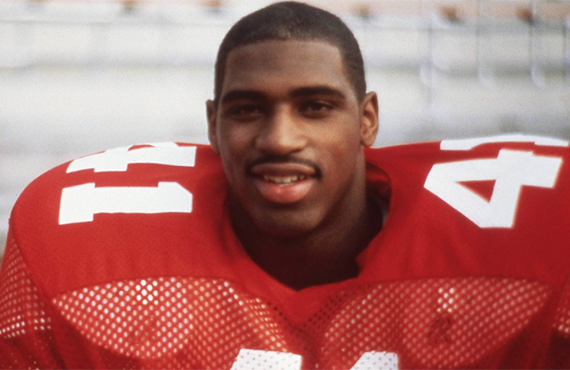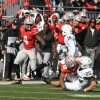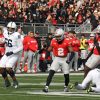
With the return of football up in the air, now serves as a perfect time for reflection on the history of football, and the strategic evolution of the game. To do that, the film study will be spending the offseason looking back at classic Ohio State games. Today’s film study revolves around Ohio State’s 1984 45-38 come-from-behind win over Illinois. There aren’t any Earle Bruce offensive playbooks online, so we’re again stuck with the tape without a supplementary playbook. Video is from this cut-up. Last week’s film study can be found here.
Keith Byars was never much for dancing. He was cut from the same cloth as some of football’s most bruising halfbacks of the 60s and 70s, much stronger and tougher than he was quick or fast, enough to earn himself the nickname “Bramble,” as a combination of Jim Brown and Earl Campbell.
At 6-2, 233 pounds, Byars was usually good for one cut per run, in the backfield, entirely as a means to get vertical as soon as he possibly could. He wasn’t going to make defenders miss, and he didn’t need to, because they usually just bounced right off of him if they tried to tackle him anywhere above the ankles. To paraphrase one of the best Tweets of all time, Byars ran like a “haunted downhill shopping cart.”
That made for a pretty straightforward job for Byars’ offensive coordinator, Glen Mason, who was entering his fifth season in the role under Earle Bruce in 1984, Byars’ junior season. Ohio State’s passing game could get creative with play action and longer-developing plays, but the rushing side had to revolve around getting Byars the ball, and giving him a lane to get up to speed without making him play against his own skillset.
To do that, Mason focused primarily on four base designs: dives, draws, off-tackle sweeps and tosses. Each one had several variations per formation, but all looked to accomplish the same thing: minimizing time spent looking for the hole, while maximizing the time spent bowling through defenders down field.
The game plan rarely changed, because it almost always worked. Byars could carry 30 times a game without really breaking a sweat, so more often than not, he was going to carry 30 times, big plays were only going to happen once or twice a game, either from Byars or freshman wideout Cris Carter. The primary goal of this offense wasn’t to put up big yardage or points, it was to smother defenses until they quit. After busting out of the Woody Hayes mold in 1981 with an elite passer in Art Schlichter, this team was a return to that ground-and-pound style.
That isn’t to say that it wasn’t at least somewhat removed from the ultra-conservative Hayes. Ohio State passed far more in 1984 than Hayes ever would have liked to see, played around with a very early version of the singleback formation, and even incorporated quite a few passes to Byars out of the backfield, as his 42 receptions led the team. Mason wasn’t reinventing the wheel with his system, but he wasn’t regressive either. He built the system around his players, and with Byars at halfback, that meant a return to the kind of punishing, sudden rushing attack that Hayes loved so much.
Against Illinois, however, the plan faltered. Dominating the trenches, grinding out yards and holding onto possession for much of the game becomes much more difficult when you’re playing from behind on the scoreboard, especially when you’re 24 points down. Early Buckeye turnovers and a strong passing attack from the Fighting Illini put Ohio State in that deep hole just 16 minutes into the game, forcing OSU to leave that drop that typical game plan for something a little more aggressive, at least until the deficit decreased to within striking range.
For the most part, that push for aggression leaned on the same thing that Ohio State had trusted for big plays for years: the play action pass. Even down 24, the threat of a handoff to Byars or backup John Wooldridge was concerning enough to drag the defense in, creating room for wideouts downfield. Add on Carter, the most athletically gifted player on the field, and Ohio State was able to ride the play action back into the game before the first half, thanks partially to two massive gains.
The first came out of that aforementioned singleback look, which Ohio State really only ever used for passing at this point. Quarterback Mike Tomczak feigns a handoff to Byars, reads Cover 2, and hits Carter in the soft spot behind the corner in the flat and the deep safety that was held inside by Tomczak’s pump fake and a crossing route from the receiver on the other side of the field. The fake to Byars in the backfield paired with his out into the flat holds the linebackers in place, keeping that intermediate space in the field wide open.
There’s nothing overly complex about this, just a well-designed pass, built to free up Carter and allow him to make a play. An early throw from Tomczak probably would have helped Carter avoid the beating that he takes when he catches the ball, but a completion is a completion, and this came at a crucial time for the Buckeyes after several failed drives to open the game.
The second proved a bit more consequential, cutting the deficit to 10 with 3:23 to play in the first half on this deep post to Carter. Tomczak again drops into a fake handoff, this time from the traditional I-formation to drag those linebackers in, with an extra flare fake to wideout Mike Lanese on a jet sweep. The fakes are just enough to throw the rushing defensive tackle off, giving Tomczak an extra split second that he needed to loft a jump ball for Carter.
The throw is poor, and the coverage is very strong, but Carter is still the best athlete on the field, so he comes down with the ball for six points the hard way. Ohio State would have had a much harder time coming back in this game, or passing the ball at all in 1984 were it not for the freakish ability of Carter.
With the game back in hand after another Buckeye touchdown to end the half trailing by just three, Ohio State was able to reestablish that original game plan: a whole lot of Byars.
The Buckeyes did it in just about every way possible, too. Off of an Illinois fumble, Ohio State took the ball and hit Illinois with a quick run off of the tackle, set up by the threat of an inside run.
The offensive line blocks as they would for a dive play, with the A gap to the left of the center serving as the expected point of attack, where Byars would have been following his fullback on a dive play. The defense reads the line, bites in on what they expected to be a dive, only to see Byars heading towards the outside, with just a single edge defender there to do anything about it. Because the seal is so good, specifically from the tight end on the play side and the fullback, the linebacker is all alone in the open field, and his teammates are stuck in the mud.
While Byars was without many moves to make defenders miss, he was still plenty fast, and – as Illinois head coach Mike White pointed out – very sudden in his movements.
“Byars did it all,” White said after the game. “He is so sudden, so versatile and has everything a good running back needs.”
In this case, that meant that Byars had no plans to hesitate or play with the stranded linebacker. He read his angle, knew he could beat him if he just kept moving, and blew right past him without any second thoughts. Once into the open field, Byars was able to chew up more yardage and put Ohio State firmly into scoring position. Three dive plays later and Ohio State was out in front, 28-24.
An Illinois field goal cut the Buckeye lead down to one, but Byars again had something to say about that, this time gashing the Illinois defense on what is now one of the most iconic plays in schools history.
Ohio State runs a simple draw play out of the pro set, a formation that the Buckeyes usually liked to pass out of. The line sells it well, keeping the linebackers in their place long enough for the backside guard and fullback to seal them off, creating tons of space for Byars, who just has to follow behind the fullback into the B gap. He gets up to speed, shrugs off an arm tackle and bursts into the secondary, launching his shoe on the way to a 67-yard touchdown to extend Ohio State’s lead.
The lost shoe and big run is what is remembered from this play, but everything, from the design to the blocking is just flawless here. The run doesn’t happen if Byars isn’t able to get downhill into open space, and the play of the blockers set it up for him perfectly. Once he got going, nobody in the stadium was going to stop him.
The same could be said of Byars’ game-winning run in the fourth quarter, breaking a tie at 38 with just 36 seconds to play to give Ohio State a 45-38 lead. The run itself is spectacular, including the individual effort at the end to work up field and slip past the defender into the end zone, but everything leading up to that moment is just as important.
Firstly, the play call. A third and goal run certainly doesn’t sound risky, but calling a toss here took some guts from Mason. The dive had been working all day, and recognizing that Illinois was going to go all out to stop it here was a great call.
Then, the blocking. The call is 49 pitch, with Byars instructed to follow his blockers to the perimeter before making that cut in, hoping to catch the defender over-pursuing. On the line, the job is mostly just to make a real mess of everything. The play side guard is pulling out wide to help on the sweep to take care of any extra linebackers or defensive backs, but the rest of the line and two additional tight ends are just here to take away everyone that Illinois puts in the box to create equal numbers on the outside.
The linebackers actually play it pretty well, with two escaping to the outside, trying to help the two defensive backs already out there. One is a little late though, so Ohio State still has a three-on-three with the guard, wideout and fullback up against a linebacker, cornerback and safety.
The guard, Jim Lachey, does just enough to keep the linebacker at bay, preventing him from blowing up the cutback, which he would have been able to do had he arrived a moment sooner than he did. He still made contact with Byars, but did so as he was crossing into the end zone. Without this block, Byars is forced out of bounds or tackled and Ohio State likely tries for a field goal to win.
The fullback, George Cooper, throws maybe the best block of the whole play, chopping down the cornerback who had played the run perfectly and was in a great position to make a play after escaping from wideout Doug Smith’s attempt to seal him off.
Because Smith is out of the play, Illinois has one defender left, and Byars just beats him, plain and simple. Football can be as complicated as you want it to be, with 300 things going on every single play, but sometimes it just comes down to one player being a physical freak like Byars, and the other just being some guy that fell over.
According to Byars, before the play, “(right tackle) Mark Krewowicz said ‘Keith, can you get three yards?’ I said, ‘Mark, I can get the three yards.’ I said ‘Hey, I’ve got to go get it. Stop me.’ ”
“We did not win because we could not stop them,” Illini coach White said after the game. He would have been better off saying “him” rather than “them,” because everyone on earth knew exactly who Illinois couldn’t stop that night.
For four free issues of the now-monthly print edition of Buckeye Sports Bulletin, no card required, sign up at the link here: https://www.buckeyesports.com/subscribe-4issue-trial/








